人教版(2019)选择性必修 第一册Unit 4 Body Language Discover useful structures V-ing总结课件(共75张PPT)
文档属性
| 名称 | 人教版(2019)选择性必修 第一册Unit 4 Body Language Discover useful structures V-ing总结课件(共75张PPT) |  | |
| 格式 | pptx | ||
| 文件大小 | 12.6MB | ||
| 资源类型 | 教案 | ||
| 版本资源 | 人教版(2019) | ||
| 科目 | 英语 | ||
| 更新时间 | 2024-01-27 19:56:48 | ||
图片预览

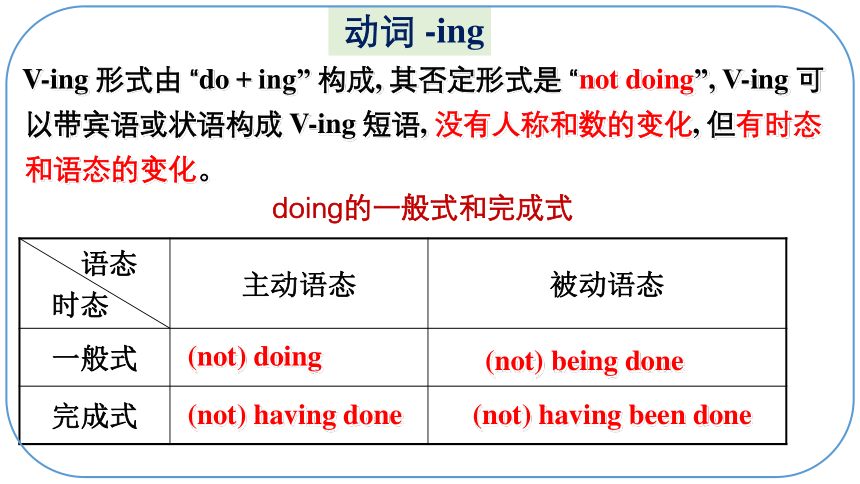
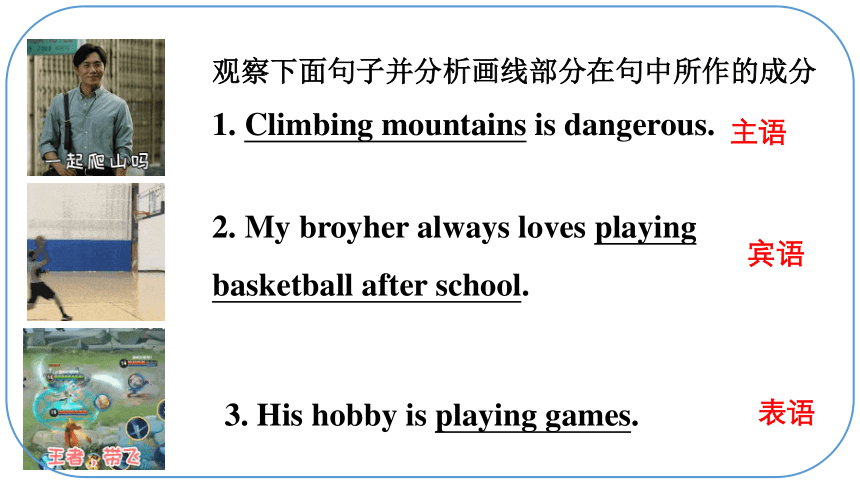

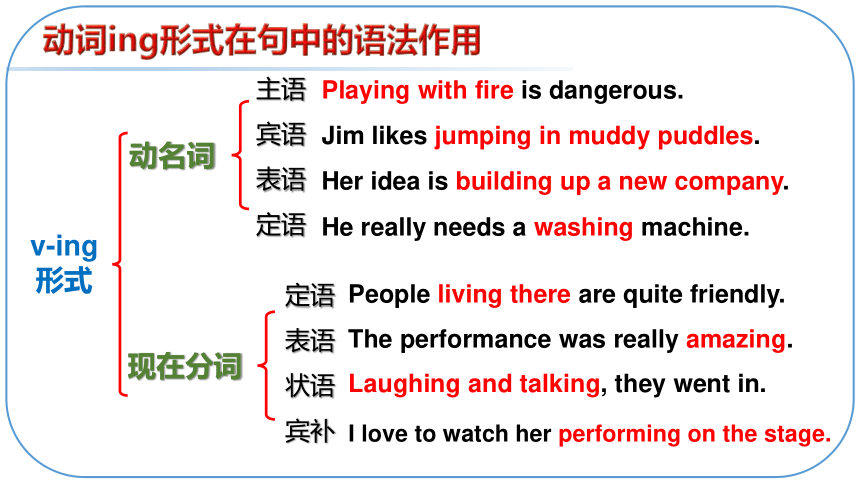
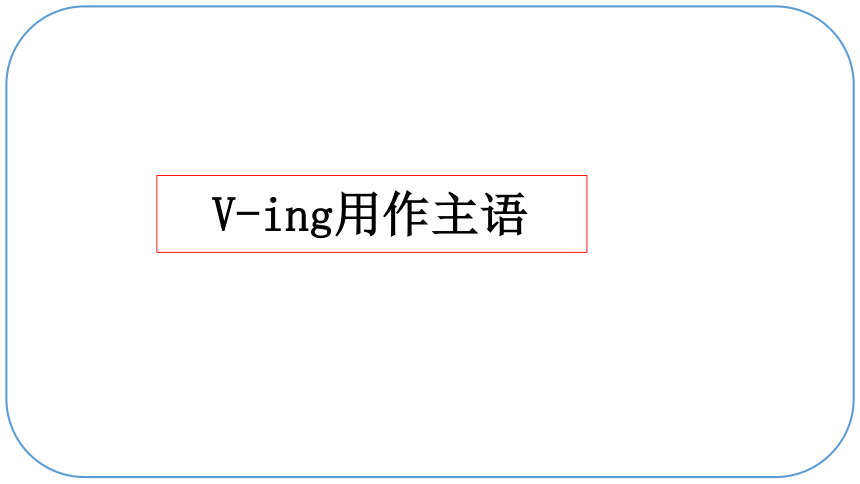
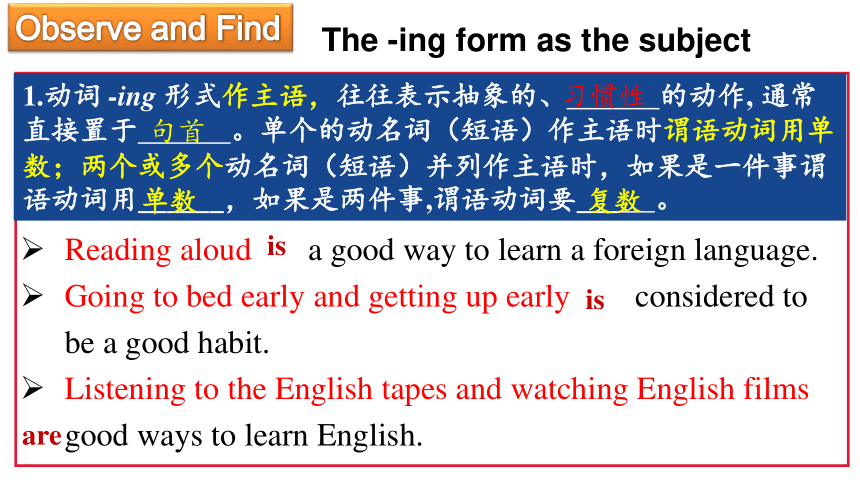
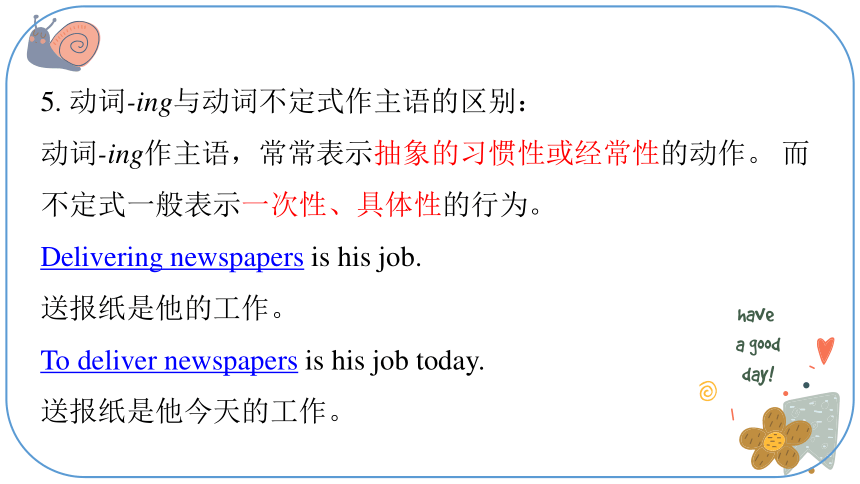

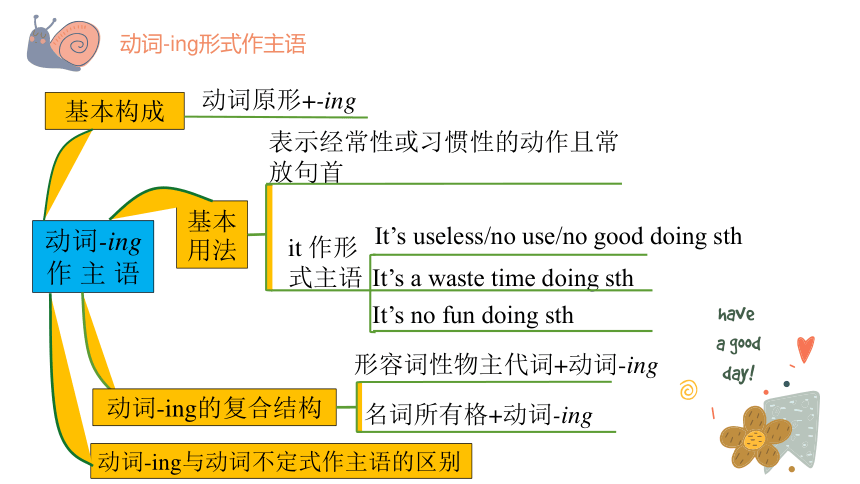
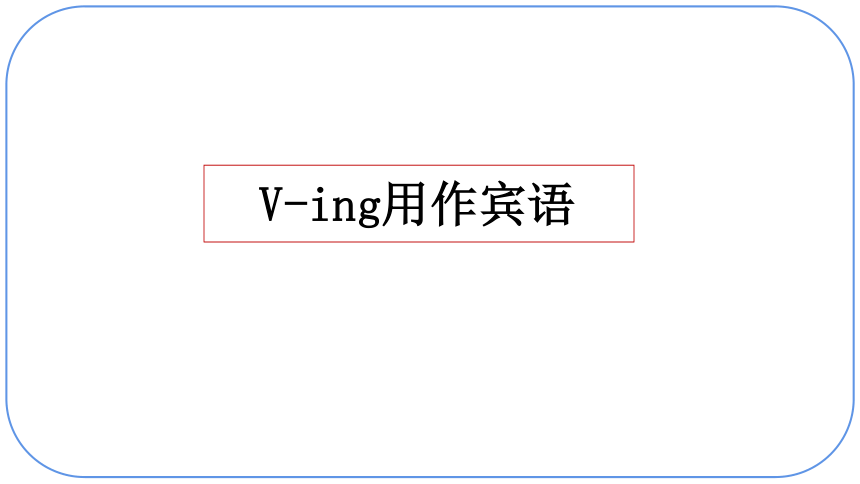
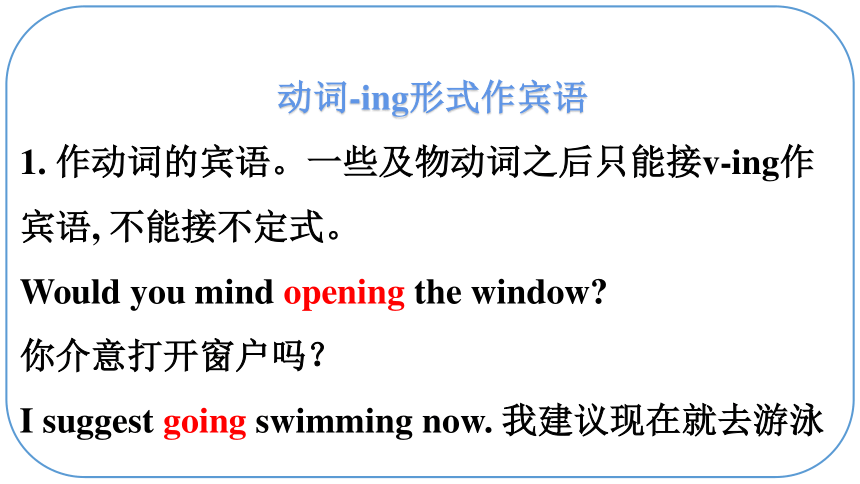
文档简介
(共75张PPT)
不定式 to do
过去分词 v-ed
动名词 v-ing
现在分词 v-ing
非谓语动词
1
2
3
4
动词
v-ing
动词-ing
动词 -ing
V-ing 形式由 “do+ing” 构成, 其否定形式是 “not doing”, V-ing 可以带宾语或状语构成 V-ing 短语, 没有人称和数的变化, 但有时态和语态的变化。
语态 时态 主动语态 被动语态
一般式
完成式
(not) doing
(not) being done
(not) having done
(not) having been done
doing的一般式和完成式
1. Climbing mountains is dangerous.
主语
2. My broyher always loves playing basketball after school.
宾语
3. His hobby is playing games.
表语
观察下面句子并分析画线部分在句中所作的成分
5. Looking down at her phone as she walked, she hit the door.
定语
4. The lady doing the live broadcast is called Qiao Biluo.
正在做直播的这位女士名叫乔碧萝。
状语
6. The head teacher saw Li Ming playing with smart phone in the classroom.
宾语补足语
定语
状语
动词 ing形式在句中的语法作用
v-ing形式
动名词
现在分词
主语
宾语
表语
定语
定语
表语
状语
宾补
Playing with fire is dangerous.
Jim likes jumping in muddy puddles.
Her idea is building up a new company.
People living there are quite friendly.
He really needs a washing machine.
The performance was really amazing.
Laughing and talking, they went in.
I love to watch her performing on the stage.
V-ing用作主语
The -ing form as the subject
Reading aloud a good way to learn a foreign language.
Going to bed early and getting up early considered to be a good habit.
Listening to the English tapes and watching English films good ways to learn English.
1.动词 -ing 形式作主语,往往表示抽象的、 的动作, 通常直接置于 。单个的动名词(短语)作主语时谓语动词用单数;两个或多个动名词(短语)并列作主语时,如果是一件事谓语动词用______,如果是两件事,谓语动词要___ 。
Observe and Find
习惯性
句首
单数
复数
is
is
are
5. 动词-ing与动词不定式作主语的区别:
动词-ing作主语,常常表示抽象的习惯性或经常性的动作。 而不定式一般表示一次性、具体性的行为。
Delivering newspapers is his job.
送报纸是他的工作。
To deliver newspapers is his job today.
送报纸是他今天的工作。
Climbing mountains can be hard work.
爬山会相当辛苦。
To climb the mountains was hard work but as we looked around us we were surprised by the view.
虽然爬那些山很辛苦,但....
(具体爬那些山行为,这对那次旅游的具体场合而言)
(指一般经常性道理)
动词-ing形式作主语
表示经常性或习惯性的动作且常
放句首
形容词性物主代词+动词-ing
名词所有格+动词-ing
动词-ing
作 主 语
动词-ing的复合结构
It’s a waste time doing sth
It’s useless/no use/no good doing sth
It’s no fun doing sth
it 作形
式主语
动词原形+-ing
基本构成
基本用法
动词-ing与动词不定式作主语的区别
V-ing用作宾语
动词-ing形式作宾语
1. 作动词的宾语。一些及物动词之后只能接v-ing作宾语, 不能接不定式。
Would you mind opening the window
你介意打开窗户吗?
I suggest going swimming now. 我建议现在就去游泳。
常接动词-ing形式作宾语的动词可用下面的口诀帮助记忆:
避免错过少延期(avoid, miss, postpone)
建议完成多练习(advise, finish, practise)
喜欢想象禁不住(enjoy, imagine, can't help)
承认否定与嫉妒(admit, deny, envy)
逃避冒险莫原谅(escape, risk, excuse)
忍受保持不介意(stand, keep, mind)
2.作介词的宾语
例:I am looking forward to seeing you soon.
我期待早日再次见到你。
Nobody objects to working for another hour today.
没有人反对今天再工作一个小时。
在下面的短语中,常用动词-ing形式作介词的宾语:
look forward to 渴望,盼望
be responsible for 对……负责
insist on坚持 object to反对,抗议
prevent…from 防止,阻止
keep…from 防止,阻止 stop…from 防止,阻止
在下面的短语中,常用动词-ing形式作介词的宾语:
devote…to献身于 set about着手做
be/get used to习惯于 be fond of喜欢
be afraid of害怕 be tired of对……厌烦
succeed in成功地做……
be interested in对……感兴趣
3.有些动词或动词短语后跟动词-ing形式或不定式都可以,但意思不同。
I remember to meet her at the station.
我记得要到车站见她。
I remember seeing her once somewhere.
我记得曾在某个地方见过她。
常见的有:
remember/ forget to do. . . 记着/忘记要做……
remember/forget doing. . . 记着/忘记做过……
regret to do. . . 遗憾要做……
regret doing. . . 后悔做了……
try to do. . . 努力/试图做……
try doing. . . 试着做……
mean to do. . . 打算做……
mean doing. . . 意味着做……
stop to do. . . 停下来去做(另一件事)
stop doing. . . 停止做……
can't help to do...不能帮着做……
can't help doing...禁不住做……
4.在有些动词的后面,如 start, begin, continue, like, love,hate,intend,prefer 等既可接动词-ing形式也可接不定式作宾语,两者意义区别不大。
They continued working/to work as if nothing had happened.
他们继续工作,似乎什么也没发生过。
5. 用it 作形式宾语, 真正的宾语是v. -ing形式。
其结构如下:
sb. +动词+it +adj. +doing
常用动词有: think, consider, find, feel, believe等
I found it useless/no use crying about it.
我发现因为这件事哭泣没用。
Do you feel it difficult trying again
再来一遍你觉得难吗
6.介词 in 常可省略的几类句型
①主语 +have a problem/ trouble/difficulty/fun (+in)+doing...
②主语+spend time(+in)+doing...
③主语+be busy(+in)+doing...
6.介词 in 常可省略
例句:I have no difficulty (in) communicating with foreigners.
我在和外国人交谈方面没有什么困难。
He used to spend a lot of time (in) playing games. 过去他常花很多时间玩游戏。
【对点训练】
①(2020·新高考全国Ⅰ卷) And contrary to existing research that says you should avoid ______(eat)with heavier people who order large portions.
②(2020·天津高考)To help us prepare for the exam, the teacher suggested __________(read) through our notes.
(2)Would you mind _________(move) the box for me
(3)We are all looking forward to ________(visit) the museum soon.
eating
reading
moving
visiting
(4)He doesn’t really mean ___________(work) here, which means __________(leave) the job soon afterwards.
(5)The deer was lucky and it just missed ______________(catch) by the hunter.
(6)Alice looks forward to ______________ (ask) to give a speech at the meeting.
(7)Have you considered ___________(look) for one special friend
to work
leaving
being caught
being asked
looking
The –ing form as the Predicative
(现在分词用作表语)
1.动名词(短语)作表语,表示抽象的一般性的行为,用来说明主语的内容,与主语通常是同一概念,表语和主语常可互换位置。
My favourite sport is swimming.
=Swimming is my favourite sport.
我最喜欢的运动是游泳。
动词 -ing 形式作表语
2.表示主语具有的特征、性质和状态(动词ing 相当一个形容词)
The problem is quite puzzling. 这个问题很令困惑。
The film being shown in the cinema is exciting.
正在电影院上演的电影很激动人心。
The news is quite shocking.这消息很令人震惊。
注意:
作表语的动词-ing 形式,许多是由能够表示人们某种感情或情绪的动词变化而来的。常见的有:moving, interesting, encouraging, exciting, inspiring, boring, surprising, puzzling, amusing, astonishing等。这类词有“令人……的”的含义,常修饰物。
3.过去分词与现在分词作表语的区别:
We are ____________(interest) in the film.
The film is ____________ (interest) to us.
Michelle sounded __________(excite) to hear the news.
The news sounded ____________(excite).
过去分词作表语一般形容人;
现在分词作表语一般形容物
interested
interesting
excited
exciting
The question is rather__________(puzzle).
puzzling
The student is quite___________(puzzle).
puzzled
inspired
Mr. Smith delivered a speech, which was very ___________ (inspire).The audience were ___________(inspire) after listenning to the speech.
inspiring
1. The plants that they found there were (astonish)
2. I was (astonish) to learn that his long lost child
had been found.
3. It is ________(amaze) that the boy played the trumpet so well at the opening ceremony.
4. He looked (interest) in the idea I put forward.
5.Please stop making the noise—it’s getting _______ (annoy).
Exercises
astonishing
astonished
amazing
interested
annoying
6. Your task is ____________(clean) the living room before the Spring Festival.
7.Her job is __________(check) letter of credit and terms of contract.
8. Be brave. You look like a ___ bird (frighten)
9. The fierce lion looks ___ (frighten). Keep away from its cage or it will attack you.
cleaning
checking
frightened
frightening
Part One
The –ing form as the Attributive
(动词ing用作定语)
V-ing作定语
一、动词ing形式作定语的意义
a sleeping baby
a barking dog
现在分词作定语表示名词的状态:进行、主动。
a washing machine
动名词作定语表示名词的性质、特征或用途。
an exhausting work
1. drinking water = water for drinking
2. tiring music = music that is tiring
3. a walking stick = a stick for walking
4. a surprising result = a result that is surprising
I. –ing form as attribute
1,3: function
2,4: action & state
动名词作定语一般表示被修饰词的_______和______。
性质
用途
现在分词作定语,表示________的或______的动作。
正在进行
主动
定语:
用来修饰、限定、说明名词或代词的品质与特征的。
汉语翻译中中常用,“......的”表示。
注意现在分词做定语的位置
an interesting film
the rising sun
1.单个的现在分词作定语时,位于它所修饰的名词或代词_____
boiling water
前面
a sleeping dog
一个睡觉的狗子
Translation
一个跳舞的女孩
a dancing girl
Do you know the man playing basketball
=Do you know the man playing basketball
2.现在分词短语作定语:通常_____,
其作用相当于定语从句。
who is
后置
Do you know the lovely cat
the piano
=Do you know the lovely cat
the piano
who is playing
playing
1. I have something interesting to say.
2. There was nothing surprising here.
3.单个的过去分词修饰复合不定代词something, everything, anything, nothing, nobody等或指示代词those时,要放在这些词的_______
后面
4.现在分词和过去分词作定语的区别
a man reading books
a used book
boiling water
boiled water
a satisfying film
a satisfied boy
1. Do you want to see the doctor ________ (work) on the case report in the office
2. Nothing _________ (report) in the newspaper interested him.
3. The child ________ (stand) over there is my brother.
4. The _________ (damage) bike was sent to the repairman.
reported
standing
damaged
working
1.The man _______ (sit) on the platform is a professor from Wuhan University.
2.Who is that girl ________ (walk) along the river
3.The stadium _________(design) last year is the biggest one in our city.
4.The man _________(stand) there is our teacher.
5.The old lady _________ (talk) to the children is a famous musician.
Exercises
sitting
walking
standing
talking
designed
2. -ing形式作表语:
① 泛指某种动作或行为, 说明____________
_________________________。
② 表示______________________。
1. -ing形式作定语:
① 单个动词的-ing形式作定语, 位于被修饰名词
的前面, 表示__________________________,
_____________________,
______________________。
② -ing形式短语作定语,相当于一个________。
定语从句
被修饰者的作用或功能
被修饰者的性质或程度
被修饰者正在进行的动作
主语所具有的特征
主语的身份、
性质或情况
(动词ing用作状语)
动词-ing形式是非谓语动词的一种,兼有动词和形容词的特征,在句中可作表语,定语,宾语补足语和状语,一般表示进行或主动的意思。
动词-ing形式用作状语时,其逻辑主语必须与句子的主语一致,动词-ing形式所表示的动作和句子的主语是主动关系。
动词-ing形式在句中可以作时间、原因、条件、让步、方式、伴随和结果状语。
动词-ing形式作状语
现在分词作时间状语时,相当于时间状语从句。可在现在分词前加连词“when, while, until”等,使其时间
意义更明确。
Walking in the park,she saw an old friend.
=When/while(she was)walking in the park,she saw an old friend. 当她在公园里散步时,她看到了她的一个老朋友。
v-ing形式作时间状语
e.g. Seeing the police, he made a run for the exit.
一看到警察,他就朝出口奔去。
分析:see的动作是由其逻辑主语“he”发出,与句子的主语he一致,且构成主动关系,所以用动词-ing形式。
将下面的时间状语从句改写成简单句。
When he walked out of the room, he saw a dog.
Walking out of the room, he saw a dog.
1. 作时间状语
现在分词作原因状语时,可转换为由since, because或as引导的原因状语从句,这类状语多放在句子的前半部分。
Being ill,he couldn't go to school.
=As he was ill,he couldn't go to school.
v-ing形式作原因状语
e.g. Being ill, he didn’t go to school yesterday.
因为生病了,他昨天没有上学。
分析: He is ill是He didn’t go to school的原因。be的逻辑主语和句子主语是一致, 主动关系。
Not knowing the way, he got lost.
翻译句子:由于不认路,他迷路了。
As he ____________________, he got lost.
didn’t know the way
动词-ing形式的否定式是在其前面加not。
2. 作原因状语
现在分词作条件状语时,可转换为if, once或unless等引导的条件状语从句。
Working hard,you'll make great progress.
=If you work hard,you'll make great progress.
v-ing形式作条件状语
e.g. Turning to the left, you will see a school.
向左转你就会看到一所学校。
If we ___________ , we will succeed.
翻译句子:努力学习, 我们就会成功。
Studying hard , we will succeed.
study hard
3. 作条件状语
现在分词作让步状语时,相当于一个以though/although引导的让步状语从句。
Working or reading,she always did her best.
=Whether she worked or read,she always did her best.
v-ing形式作让步状语
e.g. Granting this to be true, we cannot explain it.
虽然我们承认这是事实,却无法予以说明。
Knowing it is difficult, I don’t give up.
翻译句子:
虽然知道它很难,我也不放弃。
Although I _________________, I don’t give up.
know it is difficult
4. 作让步状语
现在分词作方式,结果或伴随状语时,通常不能转换为状语从句,但可用并列分句代替。
I stood by the door,not daring to say a word.
=I stood by the door,and didn’t dare to say a word.
His parents died,leaving him an orphan.
=His parents died and left him an orphan.
v-ing形式作方式/结果状语
e.g. You gave me such a fright creeping up on me like that!
你那样不声不响地从后面过来,吓我一跳!
用动词-ing形式作状语的结构翻译下列句子。
1) 请你用另一种方式回答问题。
2) 她跑进屋里来。
Please answer the question using another way.
She came running into the room.
5. 作方式状语
e.g. The child fell, striking his head against the door and cutting it. 那孩子跌倒了,头碰在门上磕破了。
He went abroad, leaving his uncle a big house.
翻译句子:
他出国了,留给他叔叔一间大房子。
He went abroad and ________his uncle a big house.
left
作结果状语
1. Having finished his homework, he rushed out to play basketball.
2.Not having studied his lessons very hard, he
failed the test.
当--ing表示的动作发生在谓语动词之前时,应使用完成式: having done.
判断下列句子是否正确。
Entering the room, I found the wall newly-painted.
Entering the room, the first thing that met eyes was the newly-painted wall.
Being very busy, the film tickets were given to others.
Being very busy, I could not afford the time to go to the cinema.
Running after each other in the street, the two boys were knocking down by a bike.
Running after each other in the street, a bike knocked down the two boys.
T
F
F
T
T
F
用-ing做状语翻译句子:
他在大街上散步到时候遇到了刘萍。
Walking along the street, he met LiuPing.
由于不知道如何做,他向老师求助。
Not knowing how to do it, he asked the teacher for help.
你能用身体语言同别人交流吗?
Can you communicate with others using body language
向右转,你就会找到那家医院。
Turning to the right, you will find the hospital.
飓风刮到了大批房屋,使得成千上万的人无家可归。
The hurricane brought down a great number of houses, making thousands of people homeless.
1. _______(hear) the news, they couldn’t help jumping.
2.Be careful when___________(cross)the street.
3.__________________(work) for three hours, he took a rest.
4.___________(use) your head, you’ll have a good idea.
5.___________(work) hard, he didn’t feel a bit tired.
6. The heavy rain lasted three days,__________(result) in serious traffic jams.
7.The girl came in,_________(follow) her parents.
8.________(walk) in the park, she saw an old friend.
9.Mary sat by the window of the classroom,_________(read) a book.
10._______________(finish) his homework, Tom listened to music.
Exercises
Hearing
crossing
Having worked
Using
Working
resulting
followling
Walking
reading
Having finished
Focus on
基本用法
(动词ing用作宾语补足语)
观察归纳:
动词-ing形式作宾语补足语常放在宾语后面, 对宾语进行补充说明表示一个____________________的动作, 强调一个过程或一种状态。
正在进行的主动性
1. 读句子,思考V-ing 作宾语补足语的作用是什么?
1) When we returned to the school, we found a
stranger standing at the entrance.
2) The boss kept the workers working the whole night.
2.接-ing形式作宾补的几类动词:
①感官动词 see, hear, feel, smell, notice, observe, look at, listen to等。
1. We saw a light burning in the window.
2. I felt someone patting me on the back.
3. Can you smell anything burning
4. Listen to the birds singing.
②使役动词:have, set, keep, get, catch, leave等.
1. I won't have you doing that.
2. This set me thinking.
3. I'm sorry to have kept you waiting.
4. I can't get the clock going again.
2.接-ing形式作宾补的几类动词:
③ 在 with的复合结构中
1. I couldn’t do my homework with the noise going on outside.
2. With so many people looking at her, she felt nervous.
1.We passed by the classroom and saw the teacher__________(make) the experiment.
2.When I came in, I saw Dr. Li _____________(examine) a patient.
3.At the airport, a man dressed in a black suit was caught _______ (spit) on the clean floor.
4.Sitting by her side, I could feel her heart__________(beat).
5.Don’t leave her ________(wait)outside in the rain.
6.The film star walked towards his car, with a crowd of journalists _________ (follow) close behind.
7.With the boy __________ (lead) the way, the soldiers managed to walk through the forest.
8. The couple often take a walk after supper in the park with their pet dog___________(follow) them.
making
examining
spitting
waiting
following
Exercises
beating
leading
following
1. All customers _________ (travel) on TransLink services must be in _________ (possess) of a valid ticket before boarding.
2. In fact, anyone _________ (wish) to try race walking should probably first consult a coach or ___________ (experience) racer _________ (learn) proper technique.
3. One of his latest projects has been to make plants grow in experiments _________(use) some common vegetables.
travelling
possession
experienced
wishing
to learn
高考链接
using
4. Nervously _________ (face) challenges, I know I will whisper to myself the two simple words “Be yourself”.
5. _______________ (work) for two days, Steve managed to finish his report on schedule.
6. All the football players on the playground cheered loudly, _____ (say) that I had a talent _________ football.
7. _________ (turn) around, we saw an old woman _________; (walk) towards the river.
高考链接
facing
Having worked
saying
for
Turning
walking
8. China’s approach to _________ (protect) its environment while _________ (feed) its citizens offers useful lessons for agriculture and food policymakers worldwide.
9. ___________ (know) which university to attend, the girl asked her teacher for advice.
10. Some students will feel a growing sense of anxiety with the exam _________ (draw) near while others may appear calm.
Not knowing
drawing
高考链接
protecting
feeding
1. Finish the exercises in Learning English.
2. Preview Listening and Talking on page 7.
THANKS
感谢观看
不定式 to do
过去分词 v-ed
动名词 v-ing
现在分词 v-ing
非谓语动词
1
2
3
4
动词
v-ing
动词-ing
动词 -ing
V-ing 形式由 “do+ing” 构成, 其否定形式是 “not doing”, V-ing 可以带宾语或状语构成 V-ing 短语, 没有人称和数的变化, 但有时态和语态的变化。
语态 时态 主动语态 被动语态
一般式
完成式
(not) doing
(not) being done
(not) having done
(not) having been done
doing的一般式和完成式
1. Climbing mountains is dangerous.
主语
2. My broyher always loves playing basketball after school.
宾语
3. His hobby is playing games.
表语
观察下面句子并分析画线部分在句中所作的成分
5. Looking down at her phone as she walked, she hit the door.
定语
4. The lady doing the live broadcast is called Qiao Biluo.
正在做直播的这位女士名叫乔碧萝。
状语
6. The head teacher saw Li Ming playing with smart phone in the classroom.
宾语补足语
定语
状语
动词 ing形式在句中的语法作用
v-ing形式
动名词
现在分词
主语
宾语
表语
定语
定语
表语
状语
宾补
Playing with fire is dangerous.
Jim likes jumping in muddy puddles.
Her idea is building up a new company.
People living there are quite friendly.
He really needs a washing machine.
The performance was really amazing.
Laughing and talking, they went in.
I love to watch her performing on the stage.
V-ing用作主语
The -ing form as the subject
Reading aloud a good way to learn a foreign language.
Going to bed early and getting up early considered to be a good habit.
Listening to the English tapes and watching English films good ways to learn English.
1.动词 -ing 形式作主语,往往表示抽象的、 的动作, 通常直接置于 。单个的动名词(短语)作主语时谓语动词用单数;两个或多个动名词(短语)并列作主语时,如果是一件事谓语动词用______,如果是两件事,谓语动词要___ 。
Observe and Find
习惯性
句首
单数
复数
is
is
are
5. 动词-ing与动词不定式作主语的区别:
动词-ing作主语,常常表示抽象的习惯性或经常性的动作。 而不定式一般表示一次性、具体性的行为。
Delivering newspapers is his job.
送报纸是他的工作。
To deliver newspapers is his job today.
送报纸是他今天的工作。
Climbing mountains can be hard work.
爬山会相当辛苦。
To climb the mountains was hard work but as we looked around us we were surprised by the view.
虽然爬那些山很辛苦,但....
(具体爬那些山行为,这对那次旅游的具体场合而言)
(指一般经常性道理)
动词-ing形式作主语
表示经常性或习惯性的动作且常
放句首
形容词性物主代词+动词-ing
名词所有格+动词-ing
动词-ing
作 主 语
动词-ing的复合结构
It’s a waste time doing sth
It’s useless/no use/no good doing sth
It’s no fun doing sth
it 作形
式主语
动词原形+-ing
基本构成
基本用法
动词-ing与动词不定式作主语的区别
V-ing用作宾语
动词-ing形式作宾语
1. 作动词的宾语。一些及物动词之后只能接v-ing作宾语, 不能接不定式。
Would you mind opening the window
你介意打开窗户吗?
I suggest going swimming now. 我建议现在就去游泳。
常接动词-ing形式作宾语的动词可用下面的口诀帮助记忆:
避免错过少延期(avoid, miss, postpone)
建议完成多练习(advise, finish, practise)
喜欢想象禁不住(enjoy, imagine, can't help)
承认否定与嫉妒(admit, deny, envy)
逃避冒险莫原谅(escape, risk, excuse)
忍受保持不介意(stand, keep, mind)
2.作介词的宾语
例:I am looking forward to seeing you soon.
我期待早日再次见到你。
Nobody objects to working for another hour today.
没有人反对今天再工作一个小时。
在下面的短语中,常用动词-ing形式作介词的宾语:
look forward to 渴望,盼望
be responsible for 对……负责
insist on坚持 object to反对,抗议
prevent…from 防止,阻止
keep…from 防止,阻止 stop…from 防止,阻止
在下面的短语中,常用动词-ing形式作介词的宾语:
devote…to献身于 set about着手做
be/get used to习惯于 be fond of喜欢
be afraid of害怕 be tired of对……厌烦
succeed in成功地做……
be interested in对……感兴趣
3.有些动词或动词短语后跟动词-ing形式或不定式都可以,但意思不同。
I remember to meet her at the station.
我记得要到车站见她。
I remember seeing her once somewhere.
我记得曾在某个地方见过她。
常见的有:
remember/ forget to do. . . 记着/忘记要做……
remember/forget doing. . . 记着/忘记做过……
regret to do. . . 遗憾要做……
regret doing. . . 后悔做了……
try to do. . . 努力/试图做……
try doing. . . 试着做……
mean to do. . . 打算做……
mean doing. . . 意味着做……
stop to do. . . 停下来去做(另一件事)
stop doing. . . 停止做……
can't help to do...不能帮着做……
can't help doing...禁不住做……
4.在有些动词的后面,如 start, begin, continue, like, love,hate,intend,prefer 等既可接动词-ing形式也可接不定式作宾语,两者意义区别不大。
They continued working/to work as if nothing had happened.
他们继续工作,似乎什么也没发生过。
5. 用it 作形式宾语, 真正的宾语是v. -ing形式。
其结构如下:
sb. +动词+it +adj. +doing
常用动词有: think, consider, find, feel, believe等
I found it useless/no use crying about it.
我发现因为这件事哭泣没用。
Do you feel it difficult trying again
再来一遍你觉得难吗
6.介词 in 常可省略的几类句型
①主语 +have a problem/ trouble/difficulty/fun (+in)+doing...
②主语+spend time(+in)+doing...
③主语+be busy(+in)+doing...
6.介词 in 常可省略
例句:I have no difficulty (in) communicating with foreigners.
我在和外国人交谈方面没有什么困难。
He used to spend a lot of time (in) playing games. 过去他常花很多时间玩游戏。
【对点训练】
①(2020·新高考全国Ⅰ卷) And contrary to existing research that says you should avoid ______(eat)with heavier people who order large portions.
②(2020·天津高考)To help us prepare for the exam, the teacher suggested __________(read) through our notes.
(2)Would you mind _________(move) the box for me
(3)We are all looking forward to ________(visit) the museum soon.
eating
reading
moving
visiting
(4)He doesn’t really mean ___________(work) here, which means __________(leave) the job soon afterwards.
(5)The deer was lucky and it just missed ______________(catch) by the hunter.
(6)Alice looks forward to ______________ (ask) to give a speech at the meeting.
(7)Have you considered ___________(look) for one special friend
to work
leaving
being caught
being asked
looking
The –ing form as the Predicative
(现在分词用作表语)
1.动名词(短语)作表语,表示抽象的一般性的行为,用来说明主语的内容,与主语通常是同一概念,表语和主语常可互换位置。
My favourite sport is swimming.
=Swimming is my favourite sport.
我最喜欢的运动是游泳。
动词 -ing 形式作表语
2.表示主语具有的特征、性质和状态(动词ing 相当一个形容词)
The problem is quite puzzling. 这个问题很令困惑。
The film being shown in the cinema is exciting.
正在电影院上演的电影很激动人心。
The news is quite shocking.这消息很令人震惊。
注意:
作表语的动词-ing 形式,许多是由能够表示人们某种感情或情绪的动词变化而来的。常见的有:moving, interesting, encouraging, exciting, inspiring, boring, surprising, puzzling, amusing, astonishing等。这类词有“令人……的”的含义,常修饰物。
3.过去分词与现在分词作表语的区别:
We are ____________(interest) in the film.
The film is ____________ (interest) to us.
Michelle sounded __________(excite) to hear the news.
The news sounded ____________(excite).
过去分词作表语一般形容人;
现在分词作表语一般形容物
interested
interesting
excited
exciting
The question is rather__________(puzzle).
puzzling
The student is quite___________(puzzle).
puzzled
inspired
Mr. Smith delivered a speech, which was very ___________ (inspire).The audience were ___________(inspire) after listenning to the speech.
inspiring
1. The plants that they found there were (astonish)
2. I was (astonish) to learn that his long lost child
had been found.
3. It is ________(amaze) that the boy played the trumpet so well at the opening ceremony.
4. He looked (interest) in the idea I put forward.
5.Please stop making the noise—it’s getting _______ (annoy).
Exercises
astonishing
astonished
amazing
interested
annoying
6. Your task is ____________(clean) the living room before the Spring Festival.
7.Her job is __________(check) letter of credit and terms of contract.
8. Be brave. You look like a ___ bird (frighten)
9. The fierce lion looks ___ (frighten). Keep away from its cage or it will attack you.
cleaning
checking
frightened
frightening
Part One
The –ing form as the Attributive
(动词ing用作定语)
V-ing作定语
一、动词ing形式作定语的意义
a sleeping baby
a barking dog
现在分词作定语表示名词的状态:进行、主动。
a washing machine
动名词作定语表示名词的性质、特征或用途。
an exhausting work
1. drinking water = water for drinking
2. tiring music = music that is tiring
3. a walking stick = a stick for walking
4. a surprising result = a result that is surprising
I. –ing form as attribute
1,3: function
2,4: action & state
动名词作定语一般表示被修饰词的_______和______。
性质
用途
现在分词作定语,表示________的或______的动作。
正在进行
主动
定语:
用来修饰、限定、说明名词或代词的品质与特征的。
汉语翻译中中常用,“......的”表示。
注意现在分词做定语的位置
an interesting film
the rising sun
1.单个的现在分词作定语时,位于它所修饰的名词或代词_____
boiling water
前面
a sleeping dog
一个睡觉的狗子
Translation
一个跳舞的女孩
a dancing girl
Do you know the man playing basketball
=Do you know the man playing basketball
2.现在分词短语作定语:通常_____,
其作用相当于定语从句。
who is
后置
Do you know the lovely cat
the piano
=Do you know the lovely cat
the piano
who is playing
playing
1. I have something interesting to say.
2. There was nothing surprising here.
3.单个的过去分词修饰复合不定代词something, everything, anything, nothing, nobody等或指示代词those时,要放在这些词的_______
后面
4.现在分词和过去分词作定语的区别
a man reading books
a used book
boiling water
boiled water
a satisfying film
a satisfied boy
1. Do you want to see the doctor ________ (work) on the case report in the office
2. Nothing _________ (report) in the newspaper interested him.
3. The child ________ (stand) over there is my brother.
4. The _________ (damage) bike was sent to the repairman.
reported
standing
damaged
working
1.The man _______ (sit) on the platform is a professor from Wuhan University.
2.Who is that girl ________ (walk) along the river
3.The stadium _________(design) last year is the biggest one in our city.
4.The man _________(stand) there is our teacher.
5.The old lady _________ (talk) to the children is a famous musician.
Exercises
sitting
walking
standing
talking
designed
2. -ing形式作表语:
① 泛指某种动作或行为, 说明____________
_________________________。
② 表示______________________。
1. -ing形式作定语:
① 单个动词的-ing形式作定语, 位于被修饰名词
的前面, 表示__________________________,
_____________________,
______________________。
② -ing形式短语作定语,相当于一个________。
定语从句
被修饰者的作用或功能
被修饰者的性质或程度
被修饰者正在进行的动作
主语所具有的特征
主语的身份、
性质或情况
(动词ing用作状语)
动词-ing形式是非谓语动词的一种,兼有动词和形容词的特征,在句中可作表语,定语,宾语补足语和状语,一般表示进行或主动的意思。
动词-ing形式用作状语时,其逻辑主语必须与句子的主语一致,动词-ing形式所表示的动作和句子的主语是主动关系。
动词-ing形式在句中可以作时间、原因、条件、让步、方式、伴随和结果状语。
动词-ing形式作状语
现在分词作时间状语时,相当于时间状语从句。可在现在分词前加连词“when, while, until”等,使其时间
意义更明确。
Walking in the park,she saw an old friend.
=When/while(she was)walking in the park,she saw an old friend. 当她在公园里散步时,她看到了她的一个老朋友。
v-ing形式作时间状语
e.g. Seeing the police, he made a run for the exit.
一看到警察,他就朝出口奔去。
分析:see的动作是由其逻辑主语“he”发出,与句子的主语he一致,且构成主动关系,所以用动词-ing形式。
将下面的时间状语从句改写成简单句。
When he walked out of the room, he saw a dog.
Walking out of the room, he saw a dog.
1. 作时间状语
现在分词作原因状语时,可转换为由since, because或as引导的原因状语从句,这类状语多放在句子的前半部分。
Being ill,he couldn't go to school.
=As he was ill,he couldn't go to school.
v-ing形式作原因状语
e.g. Being ill, he didn’t go to school yesterday.
因为生病了,他昨天没有上学。
分析: He is ill是He didn’t go to school的原因。be的逻辑主语和句子主语是一致, 主动关系。
Not knowing the way, he got lost.
翻译句子:由于不认路,他迷路了。
As he ____________________, he got lost.
didn’t know the way
动词-ing形式的否定式是在其前面加not。
2. 作原因状语
现在分词作条件状语时,可转换为if, once或unless等引导的条件状语从句。
Working hard,you'll make great progress.
=If you work hard,you'll make great progress.
v-ing形式作条件状语
e.g. Turning to the left, you will see a school.
向左转你就会看到一所学校。
If we ___________ , we will succeed.
翻译句子:努力学习, 我们就会成功。
Studying hard , we will succeed.
study hard
3. 作条件状语
现在分词作让步状语时,相当于一个以though/although引导的让步状语从句。
Working or reading,she always did her best.
=Whether she worked or read,she always did her best.
v-ing形式作让步状语
e.g. Granting this to be true, we cannot explain it.
虽然我们承认这是事实,却无法予以说明。
Knowing it is difficult, I don’t give up.
翻译句子:
虽然知道它很难,我也不放弃。
Although I _________________, I don’t give up.
know it is difficult
4. 作让步状语
现在分词作方式,结果或伴随状语时,通常不能转换为状语从句,但可用并列分句代替。
I stood by the door,not daring to say a word.
=I stood by the door,and didn’t dare to say a word.
His parents died,leaving him an orphan.
=His parents died and left him an orphan.
v-ing形式作方式/结果状语
e.g. You gave me such a fright creeping up on me like that!
你那样不声不响地从后面过来,吓我一跳!
用动词-ing形式作状语的结构翻译下列句子。
1) 请你用另一种方式回答问题。
2) 她跑进屋里来。
Please answer the question using another way.
She came running into the room.
5. 作方式状语
e.g. The child fell, striking his head against the door and cutting it. 那孩子跌倒了,头碰在门上磕破了。
He went abroad, leaving his uncle a big house.
翻译句子:
他出国了,留给他叔叔一间大房子。
He went abroad and ________his uncle a big house.
left
作结果状语
1. Having finished his homework, he rushed out to play basketball.
2.Not having studied his lessons very hard, he
failed the test.
当--ing表示的动作发生在谓语动词之前时,应使用完成式: having done.
判断下列句子是否正确。
Entering the room, I found the wall newly-painted.
Entering the room, the first thing that met eyes was the newly-painted wall.
Being very busy, the film tickets were given to others.
Being very busy, I could not afford the time to go to the cinema.
Running after each other in the street, the two boys were knocking down by a bike.
Running after each other in the street, a bike knocked down the two boys.
T
F
F
T
T
F
用-ing做状语翻译句子:
他在大街上散步到时候遇到了刘萍。
Walking along the street, he met LiuPing.
由于不知道如何做,他向老师求助。
Not knowing how to do it, he asked the teacher for help.
你能用身体语言同别人交流吗?
Can you communicate with others using body language
向右转,你就会找到那家医院。
Turning to the right, you will find the hospital.
飓风刮到了大批房屋,使得成千上万的人无家可归。
The hurricane brought down a great number of houses, making thousands of people homeless.
1. _______(hear) the news, they couldn’t help jumping.
2.Be careful when___________(cross)the street.
3.__________________(work) for three hours, he took a rest.
4.___________(use) your head, you’ll have a good idea.
5.___________(work) hard, he didn’t feel a bit tired.
6. The heavy rain lasted three days,__________(result) in serious traffic jams.
7.The girl came in,_________(follow) her parents.
8.________(walk) in the park, she saw an old friend.
9.Mary sat by the window of the classroom,_________(read) a book.
10._______________(finish) his homework, Tom listened to music.
Exercises
Hearing
crossing
Having worked
Using
Working
resulting
followling
Walking
reading
Having finished
Focus on
基本用法
(动词ing用作宾语补足语)
观察归纳:
动词-ing形式作宾语补足语常放在宾语后面, 对宾语进行补充说明表示一个____________________的动作, 强调一个过程或一种状态。
正在进行的主动性
1. 读句子,思考V-ing 作宾语补足语的作用是什么?
1) When we returned to the school, we found a
stranger standing at the entrance.
2) The boss kept the workers working the whole night.
2.接-ing形式作宾补的几类动词:
①感官动词 see, hear, feel, smell, notice, observe, look at, listen to等。
1. We saw a light burning in the window.
2. I felt someone patting me on the back.
3. Can you smell anything burning
4. Listen to the birds singing.
②使役动词:have, set, keep, get, catch, leave等.
1. I won't have you doing that.
2. This set me thinking.
3. I'm sorry to have kept you waiting.
4. I can't get the clock going again.
2.接-ing形式作宾补的几类动词:
③ 在 with的复合结构中
1. I couldn’t do my homework with the noise going on outside.
2. With so many people looking at her, she felt nervous.
1.We passed by the classroom and saw the teacher__________(make) the experiment.
2.When I came in, I saw Dr. Li _____________(examine) a patient.
3.At the airport, a man dressed in a black suit was caught _______ (spit) on the clean floor.
4.Sitting by her side, I could feel her heart__________(beat).
5.Don’t leave her ________(wait)outside in the rain.
6.The film star walked towards his car, with a crowd of journalists _________ (follow) close behind.
7.With the boy __________ (lead) the way, the soldiers managed to walk through the forest.
8. The couple often take a walk after supper in the park with their pet dog___________(follow) them.
making
examining
spitting
waiting
following
Exercises
beating
leading
following
1. All customers _________ (travel) on TransLink services must be in _________ (possess) of a valid ticket before boarding.
2. In fact, anyone _________ (wish) to try race walking should probably first consult a coach or ___________ (experience) racer _________ (learn) proper technique.
3. One of his latest projects has been to make plants grow in experiments _________(use) some common vegetables.
travelling
possession
experienced
wishing
to learn
高考链接
using
4. Nervously _________ (face) challenges, I know I will whisper to myself the two simple words “Be yourself”.
5. _______________ (work) for two days, Steve managed to finish his report on schedule.
6. All the football players on the playground cheered loudly, _____ (say) that I had a talent _________ football.
7. _________ (turn) around, we saw an old woman _________; (walk) towards the river.
高考链接
facing
Having worked
saying
for
Turning
walking
8. China’s approach to _________ (protect) its environment while _________ (feed) its citizens offers useful lessons for agriculture and food policymakers worldwide.
9. ___________ (know) which university to attend, the girl asked her teacher for advice.
10. Some students will feel a growing sense of anxiety with the exam _________ (draw) near while others may appear calm.
Not knowing
drawing
高考链接
protecting
feeding
1. Finish the exercises in Learning English.
2. Preview Listening and Talking on page 7.
THANKS
感谢观看
